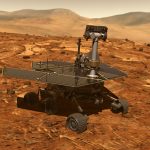Podcast: Play in new window | Download
Subscribe: RSS
Space is totally inhospitable. If the freezing temperatures don’t get you, the intense radiation will kill you. Or the vacuum, or the lack of breathable atmosphere, or meteoroid impacts. Well… you get the idea. That’s why most space exploration is done by hardy robots. They don’t need to eat, drink or breathe. They get their energy from the Sun, and they’ve proven they’ve got the right stuff to explore every planet and major moon in the Solar System. Let’s hear it for the space robots.
|
|
Shownotes
Why humans have a hard time surviving in space:
- The human body in vacuum — GSFC
- The human body in space — How Stuff Works
Robotic space missions
Other Robotics in space
- Space shuttle’s Canadarm remote manipulator system –– NASA
- SSRMS — Canadarm 2 and the Mobile Servicing System — NASA
- Comparing the space shuttle robotic arm to the ISS’s Canadarm 2 robotic arm
- Dextre, the ISS Robot
- Dextre Vs. Hal — Universe Today
Other Robotic Space missions discussed
- Cassini mission — JPL
- Hubble Space Telescope — NASA
- Hubble’s Data Handling System Failure — Universe Today
- Pathfinder Rover — JPL
- Mars Exploration Rover — JPL
- Scientific Equipment on MER — Cornell
- How to Drive the Mars Rovers — Universe Today
- Software Engineering Innovations for MER — JPL
- How the MERs work — How Stuff Works
- Deep Space 1 — NASA
- Europa “Submarine” Prototype Tests — Universe Today
- A Submarine for Europa — Universe Today
- New Horizons Mission — JHU
- Galileo Mission to Jupiter — JPL
Various Equipment/Software Needed for Robotic Missions
- RTG — Wiki
- How Do Solar Panels Supply Energy for Spacecraft? — Northwestern U
- Control Moment Gyroscopes — Wiki
- Space Communications — NASA
- Telecommunications Innovations for the Mars Exploration Rovers — JPL
Robotics Vs. Human Spaceflight
- Robotic Vs. Humans in Space — Astrobiology Magazine
- Manned Vs. Unmanned — PhysOrg.com

